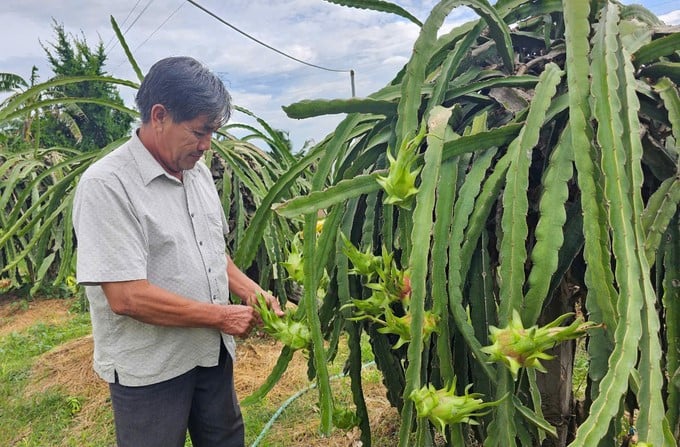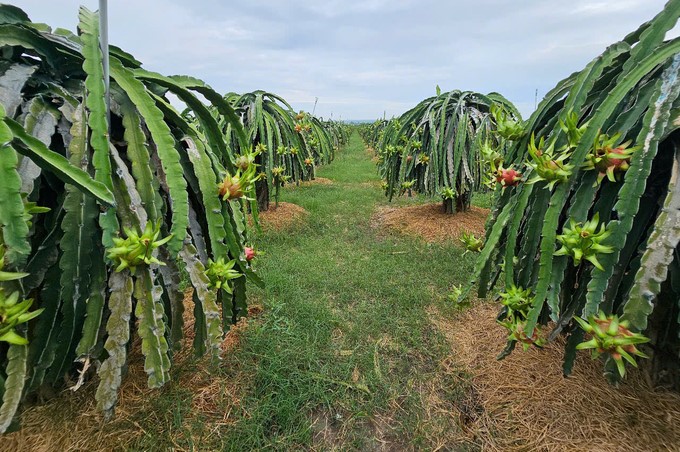November 5, 2025 | 01:10 GMT +7
November 5, 2025 | 01:10 GMT +7
Hotline: 0913.378.918
November 5, 2025 | 01:10 GMT +7
Hotline: 0913.378.918
Currently, the area of dragon fruit in Binh Thuan province is about 26,900 ha (mainly white dragon fruit). In 2024, dragon fruit output reached approximately 580,000 tons.

Binh Thuan is known as the dragon fruit production capital of the whole country. Photo: KS.
In order to improve product quality, Binh Thuan's agricultural sector has been reorganizing dragon fruit production. Of which, form dragon fruit production areas according to the export market that have been certified or granted planting area codes. At the same time, organize a linkage between concentrated production areas and dragon fruit processing and exporting businesses.
According to the Binh Thuan Department of Agriculture and Rural Development, the whole province now has over 9,500 ha of VietGAP dragon fruit and 453 ha of GlobalGAP dragon fruit. Besides, the province has 548 exported dragon fruit planting area codes and 260 exported dragon fruit packaging facility codes.
The certification mark of "Binh Thuan dragon fruit" has been registered for protection extension in 13 countries and territories, including the UK, France, Germany, Netherlands, Japan, South Korea, China, Malaysia, Indonesia, Thailand, and Taiwan (China); has been protected as a geographical indication in Japan; and has been agreed upon by the European Union (EU) for geographical indication protection in EU countries.
Mr. Bien Tan Tai, Deputy Director of the Binh Thuan Department of Industry and Trade, said that in the first 2 months of 2025, the demand for domestic fruit consumption and exports was high, so the purchasing price of dragon fruit was stable, ranging from 13,000 to 20,000 VND/kg (white dragon fruit), and farmers earned a profit.
Mr. Nguyen Trung Phuc's family in Ham Thanh commune, Ham Thuan Nam, has 700 white dragon fruit pillars. His family has recently harvested a yield of about 7 tons. With the selling price of 17,000 VND/kg, the family earned a profit of over 50 million VND.
Mr. Huynh Canh, Chairman of the Binh Thuan Dragon Fruit Association, said that since the beginning of the year, the export of dragon fruit to countries such as India and Thailand has been stable. In addition, the Russian market (a new market) has high demand for dragon fruit. For the Chinese market, the export activities are slower because before Tet, partners had imported large quantities.
However, according to Mr. Canh, when the inventory is released, the Chinese market will consume strongly. Therefore, the expected price of dragon fruit is still maintained at a stable level of 15,000–17,000 VND/kg.
According to Mr. Bien Tan Tai, in 2024, businesses in the province officially exported 10,750 tons of fresh dragon fruit, worth 11.6 million USD. In January 2025, businesses officially exported 914 tons of fresh dragon fruit, worth 1.2 million USD. The main export market is concentrated in Asian countries, accounting for 80%; Europe (Russia) accounts for 18%; the rest is Oceania.
For the Japanese market, Binh Thuan dragon fruit has been successfully registered for geographical indication protection in this country. However, businesses in the province do not directly export to Japan but sell to Ant Farm Company (Yasaka) for heat treatment and export.
For the amount of dragon fruit exported through Vietnam-China border gates, in the first 2 months of 2025, the whole country was estimated to export 160,000 tons, mostly Binh Thuan dragon fruit.
According to the Deputy Director of the Binh Thuan Department of Industry and Trade, in 2025 as well as in the coming years, China is still a large consumption market for Vietnamese agricultural products as well as Binh Thuan dragon fruit. However, the Chinese market is no longer an "easygoing" market; they enhance the application of quarantine standards of origin and labels and stricter quarantine regulations.
Additionally, importing countries in other markets (US, EU, and Taiwan-China) also offer increasingly strict regulations on food safety and tighten inspection of pesticide residues. This is also a huge challenge for the export of Binh Thuan's agricultural products in general and dragon fruit in particular. In addition, the high shipping cost also makes it difficult for businesses to complete the orders on time.
In order to ensure the consumption of Binh Thuan dragon fruit, in the coming time, the Department of Industry and Trade will preside over and coordinate with relevant units to implement a number of solutions in trade promotion and support for the promotion and development of the Binh Thuan dragon fruit consumption market according to Plan No. 3049 dated August 18, 2021 of the Binh Thuan Provincial People's Committee on the development and expansion of consumption markets for Binh Thuan dragon fruit products domestically and abroad in the 2021-2025 period.

Binh Thuan farmers are gradually improving the quality of dragon fruit. Photo: KS.
At the same time, the Department of Industry and Trade will also support dragon fruit processing and exporting businesses to participate in prestigious specialized fruit and vegetable exhibitions held annually in the region and around the world to promote and market products, seek partners and customers, and expand export markets.
Support businesses and facilities to produce and trade the province's advantage products to improve production capacity and increase competitiveness in accordance with international standards. Thereby, aiming to export OCOP products processed from dragon fruit that have been certified 3-4 stars.
Besides, the Department will also organize trade delegations under the national trade promotion program to develop the official dragon fruit market. However, in order to expand the market smoothly, the Department of Industry and Trade recommends that businesses and farmers need to strengthen the quality management of input, from planting, intensive farming, care, and harvest to pre-processing and packaging for export.
Especially, absolutely comply with the inspection regulations of the import partner, tighten the purchasing linkage chain to improve product quality, and invest in improving designs and beautiful packaging suitable for customer tastes, thereby contributing to the sustainable development of Binh Thuan dragon fruit.
Mr. Bien Tan Tai, Deputy Director of the Binh Thuan Department of Industry and Trade, suggested that businesses arrange resources and actively participate in domestic and foreign trade promotion programs in the coming time to connect trade, introduce products, and find customers and distribution channels to develop consumption markets.
Translated by Thu Huyen

(VAN) An Giang expands the model of marine fish farming using HDPE cages following VietGAP standards, linking production with consumption and eco-tourism, contributing to the development of a green economy in coastal and island areas.

(VAN) Chu Yang Sin National Park announces an invitation for investment in forest environment leasing for sustainable eco-tourism business during the 2021-2030 period.
/2025/10/31/4209-2-132711_708.jpg)
(VAN) In the future, SNE Company hopes to contribute to Viet Nam's vision of 'digital agriculture – green economy – sustainable growth.'

(VAN) Looking ahead, Japfa will continue to strengthen its integrated agricultural value chain, driven by technology and innovation.

(VAN) In addition to fresh eggs, it is necessary to develop more processed egg products such as pasteurized liquid eggs, ready-to-eat eggs, salted eggs, and century eggs to diversify and expand the market.
/2025/10/29/4026-1-102716_329.jpg)
(VAN) From a coastal village in Thanh Hoa, Le Gia has brought traditional fish sauce and shrimp paste to markets across the U.S., Japan, South Korea, and many other countries.

(VAN) According to Crawford School of Public Policy, to achieve the targets set out in Resolution 19, the agriculture sector will require VND 166 trillion in public investment during the 2026-2030 medium-term period.